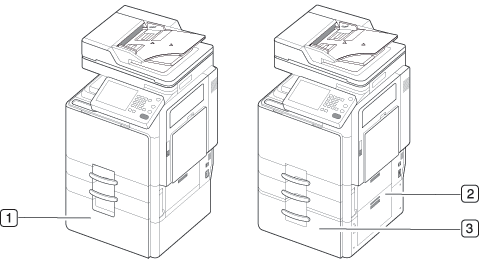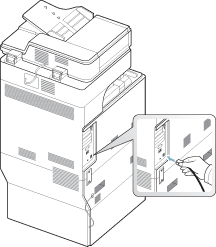Introduction
These are the main components of your machine:
This chapter includes:
Machine overview
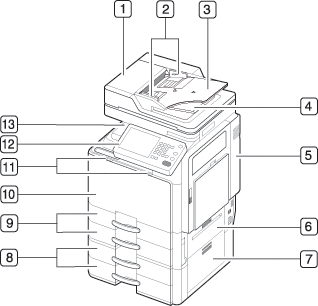
|
1 |
Duplex automatic document feeder cover |
8 |
Optional dual cassette feeder (tray 3, tray 4)[a] |
|
2 |
Duplex automatic document feeder width guides |
9 |
Standard tray (tray 1, tray 2) |
|
3 |
Duplex automatic document feeder input tray |
10 |
Front door |
|
4 |
Duplex automatic document feeder output tray |
11 |
Front door handle |
|
5 |
Multi-purpose tray |
12 |
Control panel |
|
6 |
Standard tray right bottom door |
13 |
Center tray |
|
7 |
Optional dual cassette feeder right bottom door |
† | † |
|
[a] Optional device. |
|||
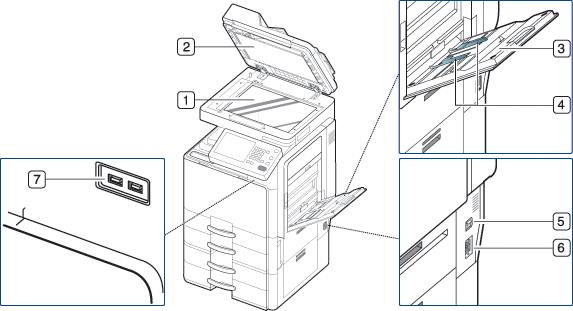
|
1 |
Scanner glass |
5 |
Power-switch |
|
2 |
White sheet |
6 |
Power receptacle |
|
3 |
Multi-purpose tray |
7 |
USB port (2 EA) |
|
4 |
Multi-purpose tray paper width guide |
† | † |
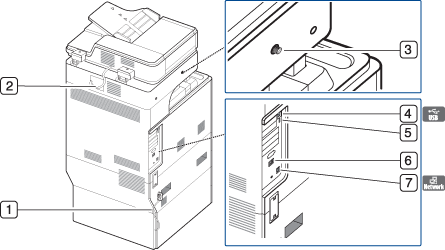
|
1 |
Optional dual cassette feeder cable |
5 |
USB host port |
|
2 |
Duplexing automatic document feeder cable |
6 |
Finisher connector |
|
3 |
Scanner locking screw |
7 |
Network port |
|
4 |
USB port |
† | † |
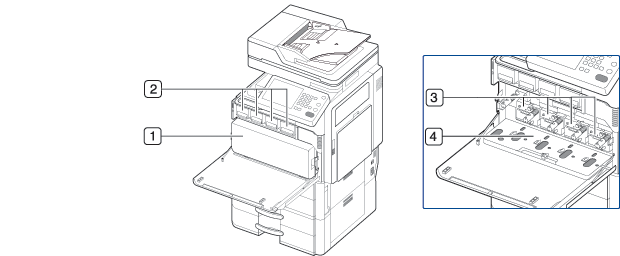
|
1 |
Waste toner container |
3 |
Imaging units |
|
2 |
Toner cartridges |
4 |
Inner cover |
![[Note]](../common/note.png)
|
|
|
If you want to see the imaging unit, you need to remove the waste toner container. Hold the left/right locking levers and push outward. Then remove the waste toner container. |

|
1 |
Waste toner container |
3 |
Imaging unit |
|
2 |
Toner cartridge |
4 |
Locking lever |
![[Note]](../common/note.png)
|
|
|
If you want to see the imaging unit, you need to remove the waste toner container. Lift the locking lever upward. Then remove the waste toner container. |
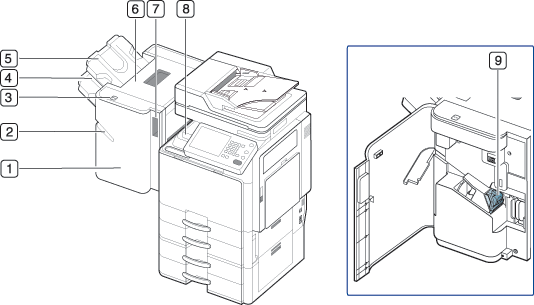
|
1 |
Standard finisher front door |
6 |
Top door |
|
2 |
Manual stapler |
7 |
Standard finisher Front door handle |
|
3 |
Manual stapler button |
8 |
Bridge unit |
|
4 |
Finishing tray |
9 |
Staple |
|
5 |
Top tray |
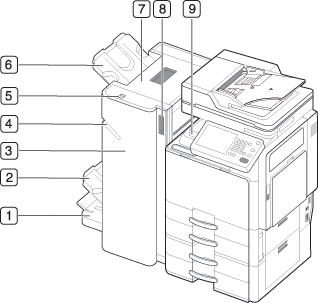
|
1 |
Booklet tray |
6 |
Top tray |
|
2 |
Finishing tray |
7 |
Top door |
|
3 |
Booklet finisher front door |
8 |
Booklet finisher front door handle |
|
4 |
Manual stapler |
9 |
Bridge unit |
|
5 |
Manual stapler button |
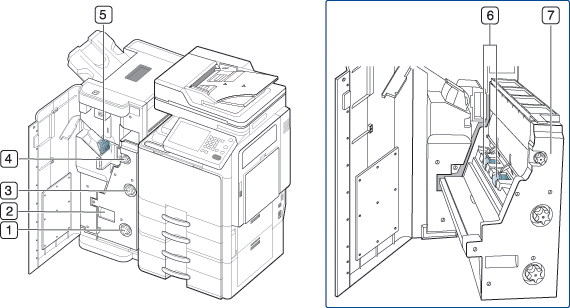
|
1 |
Knife wheel |
5 |
Staple |
|
2 |
Booklet maker handle |
6 |
Booklet Staple (2 EA) |
|
3 |
Fold wheel |
7 |
Booklet maker |
|
4 |
Booklet jam removal wheel |
† | † |
![[Note]](../common/note.png)
|
|
|
If you want to open the booklet maker, hold the booklet maker handle and pull it out. |
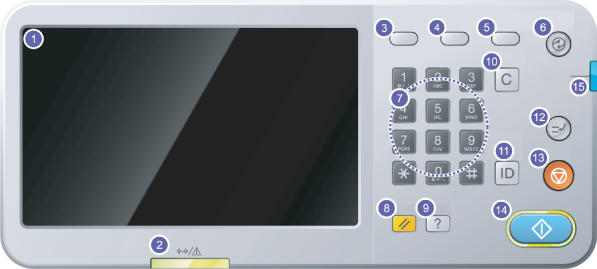
|
1 |
Display screen |
Shows the current machine status and prompts during an operation. You can set menus easily using the display screen. |
|
2 |
Status LED |
Shows the status of your machine (See Understanding the status LED). |
|
3 |
|
Shows the jobs currently running, queued jobs, completed jobs, current error code or secured jobs. |
|
4 |
|
Shows the amount of paper used (See Counter button). |
|
5 |
|
Turn into Eco mode (See button). |
|
6 |
|
Turn into power saver mode (See button ). |
|
7 |
Numeric keypad |
Dials numbers and enters alphanumeric characters. You can also enter the number value for document copies or other options. |
|
8 |
|
Resets the current machineís setup. |
|
9 |
|
Gives detailed information about this machineís menus or status. |
|
10 |
|
Deletes characters in the edit area. |
|
11 |
|
Allows user to log out. |
|
12 |
|
Stops a job in operation for urgent copying. |
|
13 |
Stops an operation at any time. The pop-up window appears on the screen showing the current job that the user can stop or resume. |
|
|
14 |
Starts a job. |
|
|
15 |
|
Turn the power on or off. When the blue LED is on, the machine is powered on and you can use it. If you turn the machine off, press this button for more than three seconds. Press when the confirmation window appears. |
![[Caution]](../common/caution.png)
|
|
|
When you use the display screen, use your finger only. The screen may be damaged with a sharpen pen or anything else. |
The color of the status LED indicates the machine's current status.
|
Status |
Description |
||
|---|---|---|---|
|
Off |
|
||
|
Green |
On |
The machine is on-line and can be used. |
|
|
Blinking |
Fax |
The machine is sending or receiving faxes. |
|
|
Copy |
The machine is copying documents. |
||
|
Scan |
The machine is scanning documents. |
||
|
|
|
||
|
Red |
On |
|
|
|
Blinking |
|
||
![[Note]](../common/note.png)
|
|
|
Check the message on the display screen. Follow the instructions in the message or refer to the troubleshooting chater (see Understanding display messages). If the problem persists, call for service. |
Turning the machine on
![[Caution]](../common/caution.png)
|
|
|
Keep in mind that you should use the power cord supplied with the machine. Otherwise, it can cause damage or fire to the machine. |
-
Plug the power cord into the power receptacle.
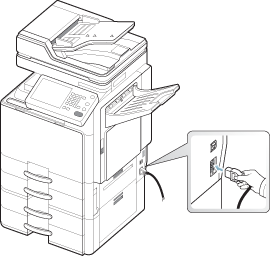
-
Plug the other end into a properly grounded AC outlet.
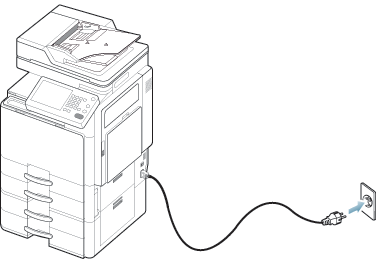
-
Turn on the main power switch.
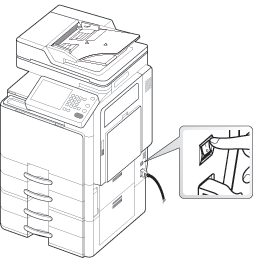
![[Caution]](../common/caution.png)
|
|
|
Turning the machine off
If you need to turn the machine off, press the button for more than three seconds on the right side of the control panel. When the confirmation window appears, press from the display screen, then wait until power is turned off automatically.
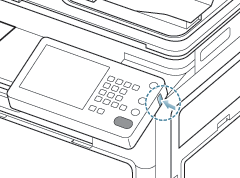
![[Note]](../common/note.png)
|
|
|
![[Caution]](../common/caution.png)
|
|
|
If you turn the machine off directly using the main power switch above the power receptacle, it could cause the hard disk problem in the machine. |
Adjusting angle of the control panel
The display screen could not be seen depending on the angle of the control panel and light. You can adjust the angle of the control panel to the direction which you want.
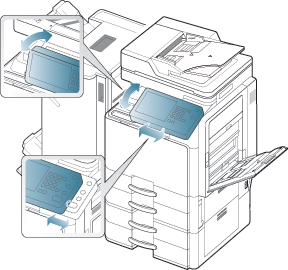
Introducing the display screen and useful buttons
Display screen
The display screen on the control panel allows user-friendly
operation of the machine. Once you press the home icon ( ) on
the screen, it shows the display screen. The display
screen image in this userís guide may differ from your
machine depending on its options or models.
) on
the screen, it shows the display screen. The display
screen image in this userís guide may differ from your
machine depending on its options or models.
![[Note]](../common/note.png)
|
|
|
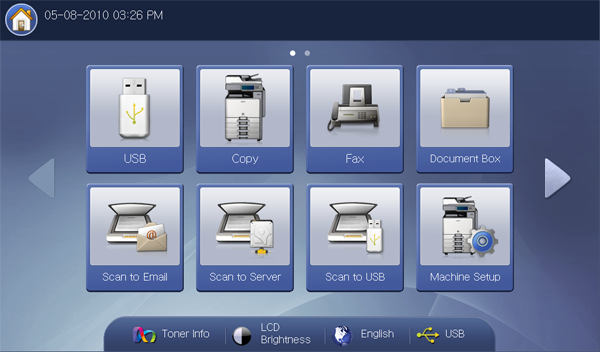
-
:†Enters the menu. When USB memory is inserted into the USB memory port on your machine, is activated on the display screen (see Using a USB memory device).
-
:†Enters the menu (see Copying).
-
:†Enters the menu. is activated on the display screen by installing optional fax kit (see Faxing (optional)).
-
:†Enters the menu (see Document box).
-
:†Enters the menu (see Scanning originals and sending through email (scan to email)).
-
:†Enters the menu (see Scanning originals and sending via SMB/WEBDAV/FTP (scan to server)).
-
:†Enters the menu. When USB memory is inserted into the USB memory port on your machine, is activated on the display screen (see Scanning originals and sending to a USB memory device (scan to USB)).
-
:†You can browse current machine settings or change machine values.
![[Note]](../common/note.png)
Some menus are only configured by an administrator or an authorized user who has registered ID and password on the machine by administrator. When the machine requests, enter the ID and password.
-
:†Shows the amount of toner used.
-
:†Adjusts brightness of the display screen.
-
 †When a USB memory device is inserted into the USB memory port
on your machine, this is activated on the display screen. When
you want to remove USB memory from the machine, press this button
and .
†When a USB memory device is inserted into the USB memory port
on your machine, this is activated on the display screen. When
you want to remove USB memory from the machine, press this button
and .
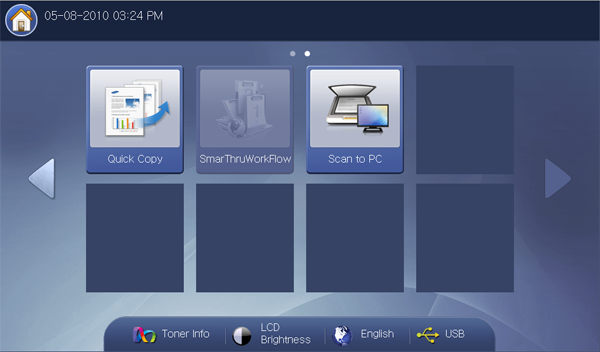
-
:†Enters the menu (see Using the menu).
-
:†Enters the menu (see Scanning originals and sending to your computer (scan to PC)).
-
:†In order to use this menu, SmarThru WorkFlow should be installed. For more information, contact your local Samsung dealer or the retailer where you purchased your machine.
button
When you press the button on the control panel, You can see the number of impressions.

When you select , you can see the number of impressions by device. Impression here means one side printing.
-
:†Displays the total number of impressions.
-
:†Displays the total number of impressions with large size paper.
-
:†Displays the number of impressions by printing.
-
:†Displays the number of impressions by copying.
-
:†Displays the number of impressions by received faxes.
-
:†Displays the number of report impressions.
-
:†Displays the number of images sent via email, server, etc.
-
:†Displays the number of sent faxes.
-
:†Prints the usage counter report.
When you select , you can see the number of usage, limit, and remaining usage by each user. For detailed information about , refer to the Administratorís Guide.
The eco feature allows you to save print resources and leads
you to eco-friendly printing. When you press the button, the machine
turns the eco mode on or off. If the eco mode is on, you
can see the eco image ( )on
some features. Some options in the features are not available
to use in the eco mode. For detailed information about
eco feature, refer to the Administratorís Guide.
)on
some features. Some options in the features are not available
to use in the eco mode. For detailed information about
eco feature, refer to the Administratorís Guide.
![[Note]](../common/note.png)
|
|
|
|
Status |
Description |
|
|---|---|---|
|
Off |
The machine is not in the Eco mode. |
|
|
Green |
On |
The machine is in the Eco mode. |
When you press the button, the screen lists the currently running, queued, and completed jobs.
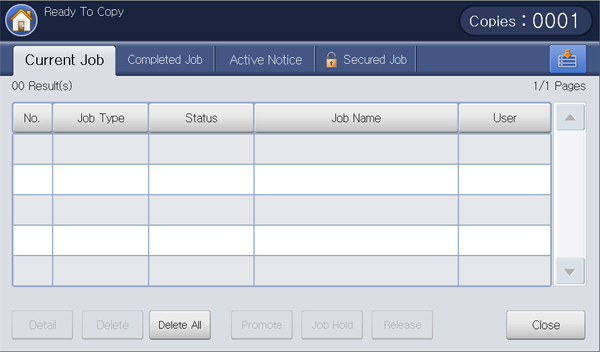
Displays the list of jobs in progress and pending.
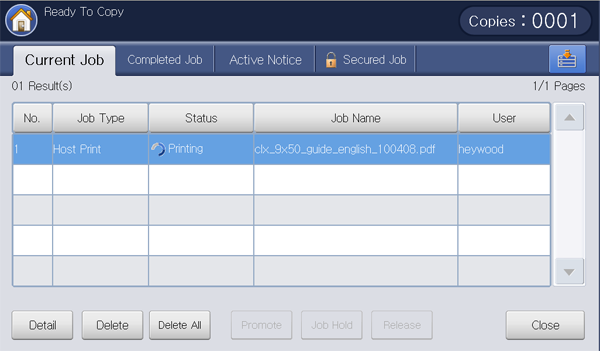
-
:†Gives the order of jobs.
-
:†Displays type of the job, such as print, copy, fax, etc.
-
:†Displays the current status of each job (see Meaning of status).
-
:†Displays the name of the job.
-
:†Displays the name of the job owner.
-
:†Displays detailed information of selected job from the list.
-
:†Removes a selected job from the list.
-
:†Removes printing jobs or all jobs from the list. When you press , all printing jobs are deleted which is .
-
:†Promotes a selected job from the list when the many jobs are queued. The selected job cannot be promoted in front of the progressing job.
![[Note]](../common/note.png)
You cannot use the button depending on the state of the job. If the button is inactivated when you select a job, the job you selected is considerably progressed.
-
:†Holds a selected job from the list.
![[Note]](../common/note.png)
You cannot use the button depending on the state of the job. If the button is inactivated when you select a job, the job you selected is considerably progressed.
-
:†Releases the held job from the list.
-
:†Closes the job status window.
Displays the list of completed jobs.
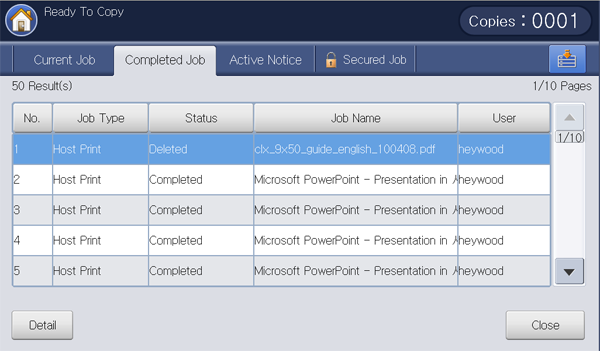
-
:†Gives the order of jobs.
-
:†Displays type of the job, such as print, copy, fax, etc.
-
:†Displays the status of each completed job (see Meaning of status).
-
:†Displays the name of the job.
-
:†Displays the name of the job owner.
-
:†Displays detailed information of selected job.
-
:†Closes the job status window.
Displays any error messages and codes that have occurred.
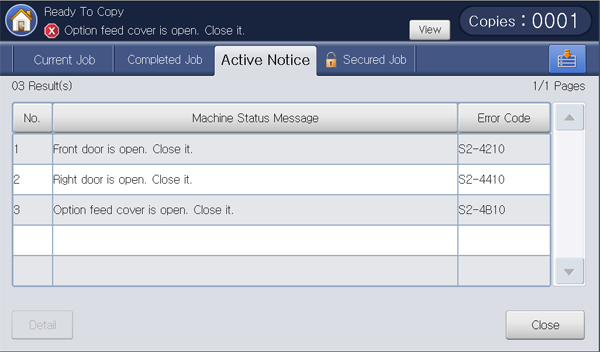
-
:†Gives the order of messages.
-
:†Displays the error message for the current errors in the machine.
-
:†Displays the error message's code.
-
:†Displays detailed information of the selected job.
-
:†Closes the job status window.
Displays the list of secured jobs the user has set in the printer driver (see ). You need to enter the and set in the printer driver (see ).
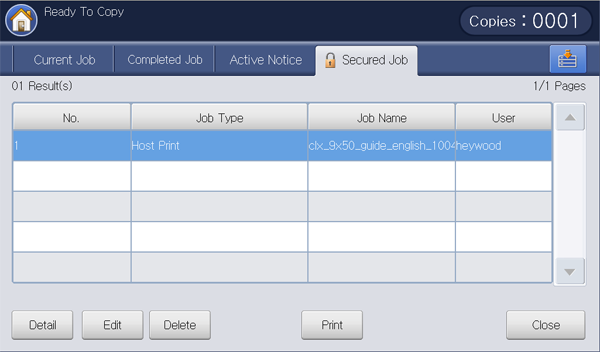
-
:†Gives the order of jobs.
-
:†Displays type of the job.
-
:†Displays the name of the job.
-
:†Displays the name of the job owner.
-
:†Displays detailed information of the selected job. You can also change the number of copies pressing .
-
:†Changes the of the selected job.
-
:†Removes the selected job from the list.
-
:†Prints the selected job from the list.
-
:†Closes the job status window.
Meaning of status
-
:†The machine is receiving data from network or fax line.
-
:†The machine is processing the image (decoding, encoding, converting data format).
-
:†The machine is generating the image for printing.
-
:†The job on the queue is waiting for its turn.
-
:†The machine is transferring the data to email, server or fax.
-
:†The machine is scanning.
-
:†In the fax mode, the machine is dialing to receiverís fax machine.
-
:†In the fax mode, the machine is waiting to connect to destination.
-
:†The machine is printing.
-
:†The data is storing to a box or a USB.
-
:†The job is temporarily stopped until the time you set for (email, fax, server).
-
:†In the tab, the job is temporarily stopped when the secure print job is sent from a computer. You can release the job pressing .
-
:†The job is temporarily stopped when the proof print job is sent from a computer. You can release the job pressing .
-
:†In the copy mode, the job is temporarily stopped when the proof copy was selected. You can release the job pressing .
-
:†The job is temporarily stopped when was pressed. You can release the job pressing .
-
:†The job is temporarily stopped until the time you set for the delay print job which is sent from a computer.
-
:†The job is temporarily stopped when the machine has problem such as paper empty, paper mismatch, etc.
-
:†The job is temporarily stopped when the button was pressed for an urgent copy job.
-
:†The job is paused when the button was pressed or the machine fault.
-
:†The job is completed.
-
:†The job is completed with error.
-
:†If you select a job in the list and press , the job is deleted.
Press the button when you have no idea how to use some function. The display screen shows the functional description in or . These guides provide information to provide a basic understanding as well as detailed explanations on each step during actual usage. Valuable for both novice and professional users, all users can refer to these guides for using the machine.

-
 †Allows you to select or .
†Allows you to select or . -
 †Prints the current view page or specific page range you set.
†Prints the current view page or specific page range you set. -
 †Reduces the guide size on the display screen.
†Reduces the guide size on the display screen. -
 †Magnifies the guide size on the display screen.
†Magnifies the guide size on the display screen. -
 †Fits the guide size on the display screen .
†Fits the guide size on the display screen . -
 †Moves to previous or next page.
†Moves to previous or next page. -
:†Closes the window.
When you press ( ), the
machine goes into interrupt mode, which means it stops
the current printing job for an urgent copy job. When the
urgent copy job completed, the previous printing job continues.
), the
machine goes into interrupt mode, which means it stops
the current printing job for an urgent copy job. When the
urgent copy job completed, the previous printing job continues.
![[Note]](../common/note.png)
|
|
|
When you select the staple feature for a printing job, interrupt mode works after a stapling completed in the printing job. |
|
Status |
Description |
|
|---|---|---|
|
Off |
The machine is not in interrupt printing mode. |
|
|
Green |
On |
The machine is in interrupt printing mode. |
You can enter alphabet characters, numbers, or special symbols using the pop-up keyboard on the display screen. This keyboard is the same as a normal keyboard for easy usability.
Touch the input area where you need to enter characters, then the keyboard pops up on the screen. The keyboard below is the default showing the lowercase letters.
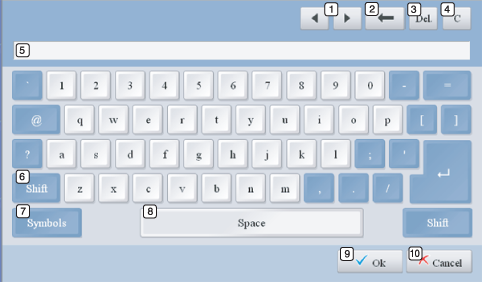
|
1 |
Arrow |
Moves the cursor between characters in the input area. |
|
2 |
Backspace |
Deletes the characters on the left side of the cursor. |
|
3 |
|
Deletes the characters on the right side of the cursor. |
|
4 |
|
Deletes all characters in the input area. |
|
5 |
Input area |
Enters letters within this line. |
|
6 |
|
Toggles between lowercase keys and uppercase keys or vice versa. |
|
7 |
|
Switches from the alphanumeric keyboard to the symbol keyboard. |
|
8 |
|
Enters a blank between characters. |
|
9 |
|
Saves and closes input result. |
|
10 |
|
Cancels and closes input result. |
You can use the manual stapler when the standard finisher or booklet finisher is installed. It is useful to use the manual stapler in filing several pages. The way to use the manual stapler is same as that of the standard finisher and booklet finisher.
-
Arrange the documents before stapling.

-
Press the manual stapler button at the top of the finisher. When the green light in on, the manual stapler is ready to stapling.
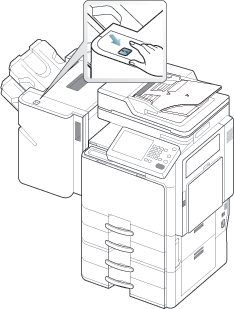
-
The first page of the printed documents should face the bottom. Insert the documents into the manual stapler so that the upper right part of the documents will be stapled.
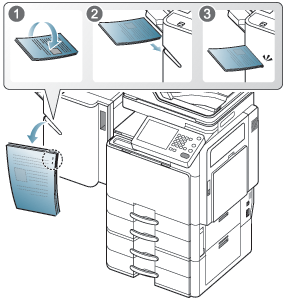
If the documents get inserted properly, the manual stapler button will blink three or four times and then staple with flipping sound.
Using the pen and paper clip holder
You can keep pens, paper clips and other small office supplies in the Pen and Paper Clip Holder. The Pen and Paper Clip Holder has a magnet inside to prevent the paper clips from scattering.
![[Caution]](../common/caution.png)
|
|
|
Do not place cards which have magnetic strip on the pen and paper clip holder. it could be damaged by magnetic forces. |
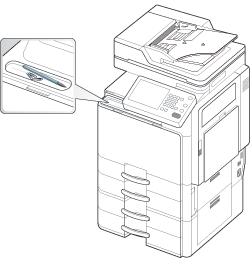
Viewing the animation for trouble shooting
When the problems in the machine occur, some error messages are shown with animations to help you solve the problems. You can see the animation to shoot the trouble pressing .
![[Note]](../common/note.png)
|
|
|
This machine does not show the animations of all the problems. For the errors of which messages are not shown with animation, refer to the troubleshooting chapter (see Understanding display messages). |
The screens below show an example animation.
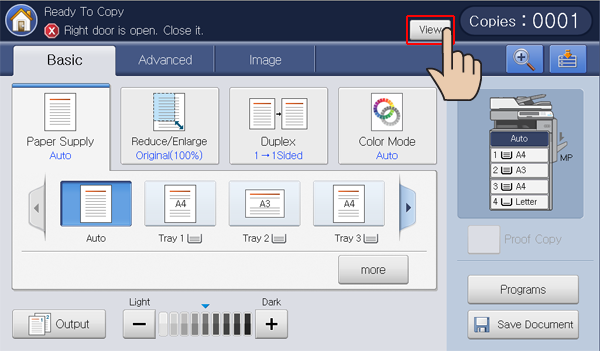
Follow the instructions on the screen to solve the concerned problem.
